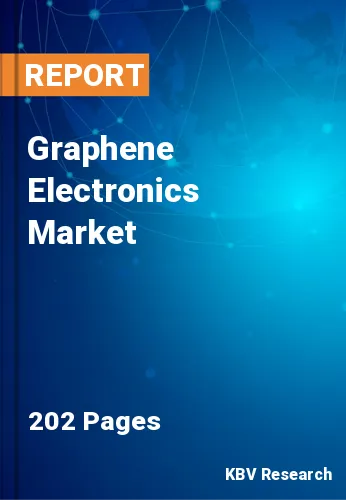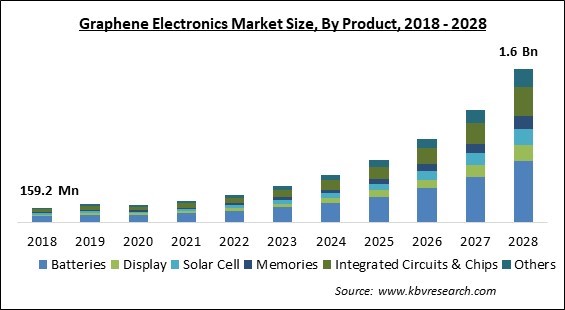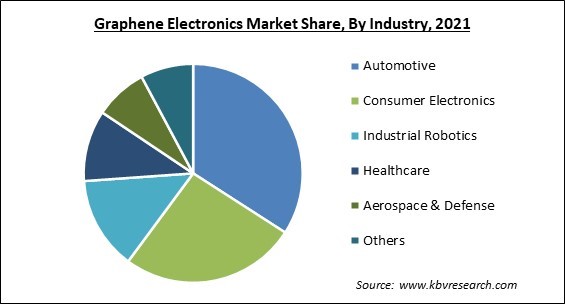
The Global Graphene Electronics Market size is expected to reach $1.6 billion by 2028, rising at a market growth of 32.7% CAGR during the forecast period.
Graphene is the first 2-D carbon substance discovered. As a result, graphene is suitable for a wide range of uses in the electronics industry. Compared to steel, Graphene is 200 times stronger, 200 times lighter than air, a good conductor of electricity, and fire-resistant. Graphene is also valued as a powerful catalyst in the chemical industry due to attributes including its absorption capacity and high surface area.

The next-generation semiconductor technology may be developed using graphene, which conducts electricity better than existing electrode materials. The revolutionary material known as graphene is composed of a graphite atoms' single layer arranged as a single sheet. Graphene has several beneficial properties, some of which include improved heat conductivity, excellent mechanical strength, and extremely high electron mobility.
Due to graphene's distinctive characteristics of conductivity and thinness, which include its use in a variety of electronic device components, like batteries, sensors, solar cells, and more, extensive studies have been conducted on graphene's potential uses as a semiconductor. Current computer chip technology might be replaced by graphene semiconductors, as these can conduct electricity at room temperature and are only one atom thick.
Graphene has the ability to produce composite materials with exceptional properties and improve the strength and conductivity of bulk materials. Composite materials are created by mixing two or more substances with different qualities to create an end product with distinctive attributes. Similar processes are used in the production of graphene composites.
The COVID-19 pandemic had a substantial negative impact on the expansion of the graphene electronics market. The pandemic propagated the lack of a skilled workforce to create next-generation graphene electronics, including batteries, memories, displays, and other products. It also affected the demand for the production of final components and raw materials utilized in consumer industries. Several businesses that had reservations about the advantages of digitalization joined on board as a result of the pandemic. Flexible electronics for business applications consequently received new prospects, leading to the greater use of graphene on electronic products.
Due to the growing popularity of mid- and high-end laptops, smartphones, wearables, gaming consoles, and other devices that employ these chips for non-volatile and volatile memory, the application of memory devices has experienced a tremendous increase. Low power consumption, high uniformity, increased density, SET voltage modulation, transparency, and other factors are expected to cause memory device manufacturers to shift their attention to the creation and incorporation of graphene in their products. This should help graphene-based memory systems gain more traction in the market for consumer electronics in the future.
Due to its superior thermal conductivity, great mechanical strength, rapid electron mobility, and other features, the usage of graphene for the creation of lower-power-consuming and faster electronics have significantly increased during the past few years. A Hall Effect sensor based on graphene that delivers a quicker, more direct assessment of the magnetic field with the precision and range needed for precise battery cell mapping was introduced by a UK-based company. This sensor has been developed to replace rare metal indium in electronic devices. According to analysis, the OEMs' increasing focus on creating electrical goods based on graphene is greatly aiding the market growth.
Graphene is an efficient conductor of electricity, yet, like graphite, it cannot be shut off because it lacks a band gap. Recently, scientists employed a process called laser shock imprinting to permanently alter the band gap structure in graphene. During this process, shockwave impulses generated by a laser were directed at a graphene sheet beneath it. These laser shocks permanently shaped the graphene layer as they forced it into a trench-like mold. Although the method allows for greater versatility in utilizing the optical, magnetic, and thermal properties of graphene, there remains a large delay to market for commercializing graphene into semiconducting devices.
Based on industry, the graphene electronics market is categorized into consumer electronics, automotive, healthcare, industrial robotics, aerospace & defense, and others. The automotive segment garnered the highest revenue share in the graphene electronics market in 2021. With numerous essential uses, including tires, electronics, fluids, and fluidic systems, graphene exhibits significant potential and drives the segment's growth. Since touchscreens and liquid-crystal displays (LCDs) are the most common types of user interfaces, graphene is a desirable material that might be employed in various user interfaces.
On the basis of product, the graphene electronics market is divided into display, memories, batteries, solar cell, integrated circuits & chips, and others. The integrated circuits and chips segment witnessed a significant revenue share in the graphene electronics market in 2021. Numerous researches have been focused on developing high-speed electron circuits and devices to take advantage of graphene's exceptional electrical characteristics in high-frequency applications. The electrical abilities of graphene electronics and their applicability for high-frequency purposes are expected to be enhanced by the large-area graphene sheets' high electron mobility.

| Report Attribute | Details |
|---|---|
| Market size value in 2021 | USD 228.4 Million |
| Market size forecast in 2028 | USD 1.6 Billion |
| Base Year | 2021 |
| Historical Period | 2018 to 2020 |
| Forecast Period | 2022 to 2028 |
| Revenue Growth Rate | CAGR of 32.7% from 2022 to 2028 |
| Number of Pages | 202 |
| Number of Tables | 320 |
| Report coverage | Market Trends, Revenue Estimation and Forecast, Segmentation Analysis, Regional and Country Breakdown, Companies Strategic Developments, Company Profiling |
| Segments covered | Product, Industry, Region |
| Country scope | US, Canada, Mexico, Germany, UK, France, Russia, Spain, Italy, China, Japan, India, South Korea, Singapore, Malaysia, Brazil, Argentina, UAE, Saudi Arabia, South Africa, Nigeria |
| Growth Drivers |
|
| Restraints |
|
Based on region, the graphene electronics market is analyzed across North America, Europe, Asia Pacific, and LAMEA. The Asia Pacific region procured the highest revenue share in the graphene electronics market in 2021. Due to the presence of major producers of consumer electronics, such as mobile phones and smart TVs, in the region, graphene-based components are being used in many products. Additionally, the regional market is anticipated to experience growth due to the potential usage of graphene films, substituting the indium tin oxide as a transparent conductor in smart TVs, solar cells, smartphones, tablets, and wearable electronics.
Free Valuable Insights: Global Graphene Electronics Market size to reach USD 1.6 Billion by 2028
The market research report covers the analysis of key stake holders of the market. Key companies profiled in the report include Samsung Electronics Co., Ltd. (Samsung Group), Talga Group Ltd., NanoXplore, Inc., Versarien plc, AMG Advanced Metallurgical Group N.V., Haydale Graphene Industries PLC, First Graphene Ltd., Graphenea, Graphene Platform Corporation, and Graphene Square, Inc.
By Product
By Industry
By Geography
The global Graphene Electronics Market size is expected to reach $1.6 billion by 2028.
Increasing need for electronic memory devices are driving the market in coming years, however, High initial investment and other challenges associated with the use of graphene restraints the growth of the market.
Samsung Electronics Co., Ltd. (Samsung Group), Talga Group Ltd., NanoXplore, Inc., Versarien plc, AMG Advanced Metallurgical Group N.V., Haydale Graphene Industries PLC, First Graphene Ltd., Graphenea, Graphene Platform Corporation, and Graphene Square, Inc.
The Batteries segment acquired maximum revenue share in the Global Graphene Electronics Market by Product in 2021 thereby, achieving a market value of $643.2 million by 2028.
The Asia Pacific market dominated the Global Graphene Electronics Market by Region in 2021, and would continue to be a dominant market till 2028; thereby, achieving a market value of $673.2 million by 2028.
Our team of dedicated experts can provide you with attractive expansion opportunities for your business.
